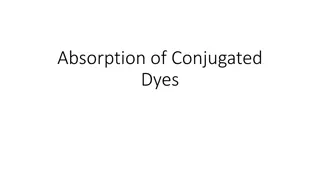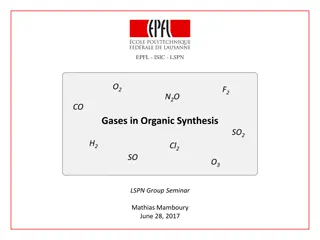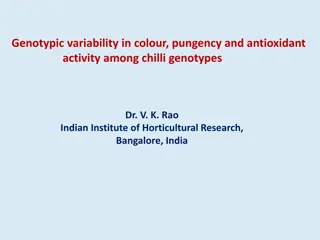Understanding Colour in Organic Molecules through Conjugated Systems
Conjugated systems in organic molecules exhibit alternating single and double bonds, leading to unique molecular orbitals and absorption patterns. With increased conjugation, molecules can absorb visible light, producing vibrant colors like the red from lycopene in tomatoes.
Download Presentation

Please find below an Image/Link to download the presentation.
The content on the website is provided AS IS for your information and personal use only. It may not be sold, licensed, or shared on other websites without obtaining consent from the author. Download presentation by click this link. If you encounter any issues during the download, it is possible that the publisher has removed the file from their server.
E N D
Presentation Transcript
COLOUR IN ORGANIC MOLECULES Conjugated Systems
A conjugated system exists when a molecule has alternating single and double bonds. For example buta-1,3-diene has the following structure.
Each carbon will have undergone sp2hybridisation and will be forming 3 sigma bonds. This leaves 4 x 2pzorbitals to overlap and 4 electrons left to form 2 pi bonds. However, the number of possible in phase/out of phase overlaps means that there are 4 possible sets of molecular orbitals.
The significance of this diagram is that, with increased possibilities for both bonding and antibonding orbitals, the gap between the highest occupied (bonding) molecular orbital (HOMO) and the lowest unoccupied (antibonding) molecular orbital (LUMO) is decreasing.
Buta-1,3-diene, only absorbs in the UV region of the EMS but molecules with larger conjugated systems will absorb from the Visible spectrum and produce colours. For example, Lycopene, which is responsible for the red colour in tomatoes.
Organic molecules contain bonding orbitals ( & ) and non-bonding (lone pair) orbitals (usually designated the letter n). In addition they also have anti-bonding molecular orbitals ( *& *).
This increases the number of possible transitions that would involve electrons absorbing energy to move from the round state ( , or n) to an excited state ( *or *). However, even the lowest of these ( to *) is within the UV region and, therefore, unlikely to give rise to a visible colour, without the effect of conjugation.
A chromophore is the part of a molecule responsible for its colour. This is usually a reasonably large part of the molecule usually involving a conjugated system.
Vitamin A has a conjugated system that spreads over 5 C=C bonds. It appears yellow.
The colour observed will be the complementary colour to the one being observed.
In the case of Vitamin A, the gap between the HOMO and the LUMO has decreased to the point where the absorbance has moved from the UV to the visible part of the spectrum dark blue to be precise. In the case of -carotene, the conjugated system spreads over 11 C=C bonds. This reduces the gap between HOMO and LUMO even further so the light absorbed decreases (energy) from dark blue (445nm) to light blue (475nm). The colour observed will be correspondingly higher (energy) so -carotene is orange.
ABSORBED COLOURS + COMPLEMENTARY COLOURS Green Absorbs red (very small gap) Blues Absorbs yellow (small gap) Violets Absorbs greeny-yellow (smaller medium gap) Reds Absorbs green (medium gap) Oranges Absorbs light blue (large gap) Yellows Absorbs dark blue (very large gap)
EXAMPLES OF COLOURED MOLECULES Greens Chlorophyll - Absorb mostly in the red and blue wavelengths, leaving a reflected green colour.
INDIGO Dark blue dye commonly synthesised to colour blue jeans.
PUNICIN Violet in colour, the compound is derived from shells of tropical sea snails.
CARMINIC ACID Deep red in colour, produced in the scales of insects.
HEME B Deep red in colour, responsible for the transfer of gases in organisms with blood.
CROCETIN Golden yellow in colour, found in saffron.
AZO-DYES Molecules are based on the above structure, where R and R can be aryl or alkyl, which can produce very vivid colours. A typical azo compound is 4-hydroxyphenylazobenzene.
The Azo molecule has the ability to incorporate the lone pairs on the nitrogen atoms which reduces further the gap between HOMO and LUMO. Delocalisation of electrons in aryl azo compounds produce vivid colours, especially reds, oranges and yellows. Some azo compounds can be used as acid-base indicators, e.g. methyl orange.























